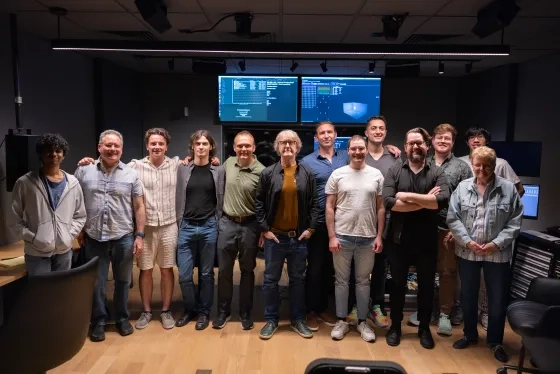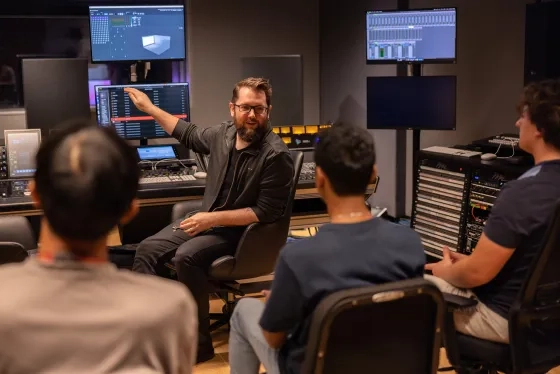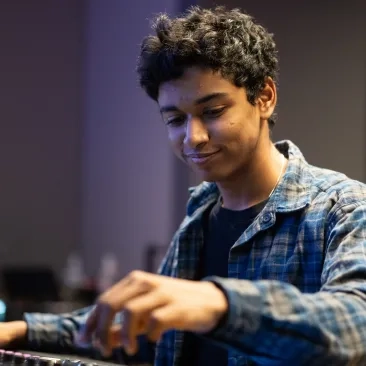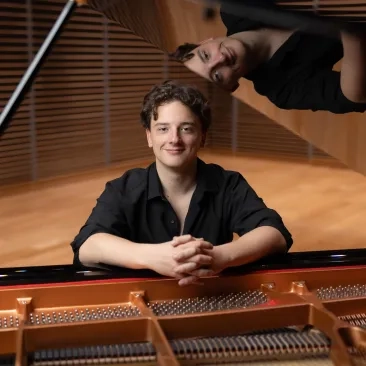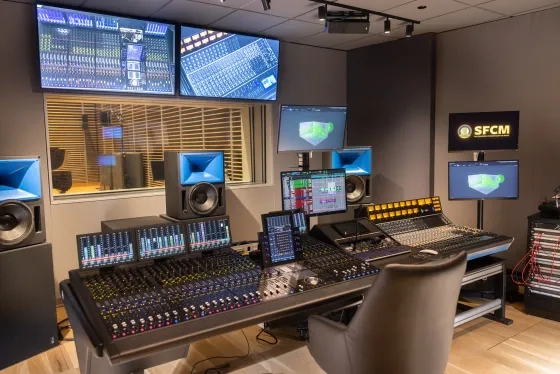Space Odyssey: TAC Students’ Year-Long Education in Spatial Audio
Technology and Applied Composition students get a ground-up view of what “spatial audio” really means for the future of music—and their careers.
SFCM’s flagship Studio G may be two stories underground, but the Conservatory’s students are exploring space there.
The Technology and Applied Composition (TAC) Department makes extensive use of the live room Studio G and its mixing room, Studio H to keep Conservatory students up-to-date on every possible direction their music can go. With Studio Manager Doug McCausland’s Spatial Audio course, this includes up, down, sideways.
“This is a year-long course,” McCausland (below, at mixing desk) explains, “and its two halves focus on building up an understanding of spatial audio; how it functions aesthetically, but also perceptually. We talk about everything from cognitive perception of sound in space to how the different elements of spatial audio function and interlink with one another.”
“Spatial audio” is a catch-all term for speaker arrays that depart from traditional two-channel (left, right) or surround-sound mixes by having different elements of a song’s mix placed at various points in a 360° field around a listener. Dolby’s Atmos system is currently one of the most popular examples of spatial mixing, as well as Apple’s spatial audio feature in its current line of AirPods.
McCausland’s course builds up to that by starting at some of the earliest ways recorded music has sought to evoke the sensation of dimension and space, beginning with one-speaker mono mixes. “Even with something like that,” he explains, “you can make something limited like that sound spatially rich—everything from speaker placement to reverbs from different rooms or spaces goes into that. We’ll take speakers into the stairwells to see how sound travels across different heights and rooms, or record balloon pops to capture a space’s reverb.”
TAC 2025 graduate Udit Srivathsan says, “Spatial audio is a bit of a Wild West situation right now, so learning everything out there relating to this is going to be beneficial. Doug is very open and gives valuable feedback on everything, so just picking his brain on what his ears pick up spatially and his just two cents in general has been really helpful.”
McCausland continues, “Earlier in the year we’re essentially adding speakers until we get to the point where we're working in a circular array of eight-ish speakers, but still fundamentally in a flat plane. The trickiest part becomes when you add height, when you add that third axis. So we look at everything from Vector-Base Amplitude Panning to Ambisonics, from free research tools to software packages like SPAT Revolution and Dolby Atmos. Their capstone for the first semester was to create a project that was in what's called third-order ambisonics, a spherical 3D format that can be flexibly deployed, or decoded, to any speaker resources that are available—in this case in Studios G and H.”
“Spatial is here,” McCausland finishes. “It's been here for a while. So we’re really looking at it from the perspective of what has been, what’s ubiquitous now, and what's coming.”
Srivathsan and fellow 2025 graduate Cullen Luper took an expansive view of the open-ended yearlong assignment the course is built around, creating an original composition combining their respective instruments and featuring a wild array of collaborators, from fellow students to members of St. Dominic’s Catholic Church in San Francisco.
Luper explains, “Udit and I wanted to do our own project that proved we used all of the resources available by the time we walked out of here. So we combined recorded music with a story, some light visual elements and sound design, and then mixed all of that in for spatial audio. We recorded a string ensemble with like 20 of our friends, we recorded a brass ensemble with nine people; we did a woodwind quintet session. Udit comes from a Hindustani classical background and he added that; everything from harp to musical saw also ended up in this.”
Their work was presented to committees that included not only McCausland and SFCM Director of Recording Jason O’Connell, but GRAMMY-winning engineers like Leslie Anne Jones (Director of Music Recording and Scoring at Skywalker Sound) and Michael Romanowski (owner and Chief Engineer at Coast Mastering in Berkeley) as well as Dolby’s John Scanlon and Sony’s Anthony Caruso.
Luper sees his experience with spatial audio having an impact on his live performance career. “I think it's going to become more common for performers and venues to be able to utilize spatial audio the way it's become common in fixed media,” he says. “So that sits at the intersection of my interests: I compose, but I'm definitely a performer at heart because that's what I've been my whole life. And spatial, I think, can really help you build a bridge between what you’re able to do with recorded audio and what you can do in a live setting.”
Srivathsan has already done Atmos mixing for not only SFCM’s alliance partner label PENTATONE Records but an independent release for TAC faculty Matt Levine and other projects around the city. In December 2024, he began working as a contracted Associate Music Designer for Sony Interactive, months before he even graduated.
“Michael Romanowski told me that you have to treat spatial mixing as a different thing from stereo mixing,” he says. “You're listening to it with a completely different speaker environment and the constraints of stereo don't always apply, but there are also new ones.”
“Stereo mixes can feel tighter and maybe higher-energy, because everything is coming out of two speakers,” Srivathsan allows. “But when you spread music out in spatial and listen to it in the right speaker environment, it’s like… how could you go back to stereo?”
Learn more about studying Technology and Applied Composition at SFCM.
